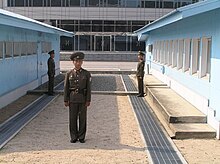Our website is made possible by displaying online advertisements to our visitors.
Please consider supporting us by disabling your ad blocker.
Joint Security Area
| Joint Security Area | |
 South Korean soldiers standing guard at the JSA between the blue buildings. View from the south. To the rear, three-story Panmungak Hall, in North Korea. | |
| Korean name | |
|---|---|
| Hangul | 공동경비구역 |
| Hanja | |
| Revised Romanization | Gongdong Gyeongbi Guyeok |
| McCune–Reischauer | Kongdong Kyŏngbi Kuyŏk |

The Joint Security Area (JSA, often referred to as the Truce Village or Panmunjom) is the only portion of the Korean Demilitarized Zone (DMZ) where North and South Korean forces stand face-to-face.[1][2] The JSA is used by the two Koreas for diplomatic engagements and, until March 1991, was also the site of military negotiations between North Korea and the United Nations Command (UNC).
The JSA has been the site of numerous events and incidents since its establishment in 1953, the first of which was the repatriation of prisoners of war (POWs) after the cessation of hostilities, across the Bridge of No Return. In 2018, North and South Korean officials agreed to clear the JSA of all landmines, weapons and guard posts. This withdrawal was complete on October 25, 2018, and the JSA now just contains 35 unarmed security guards.[3][4][5][6] It was further agreed that henceforth, the area will serve mainly as a tourist attraction.[7][8][9][10] On November 6, 2018, it was announced that the UNC would transfer primary guard duties of the now demilitarized Joint Security Area to both North and South Korea.[11][12]
- ^ "Korea Truce Village At Peace". Spacewar.com. Archived from the original on December 1, 2017. Retrieved November 28, 2011.
- ^ "Despite tensions, tourists flock to Korean DMZ". NBC News. November 4, 2006. Archived from the original on September 23, 2020. Retrieved November 28, 2011.
- ^ "S.Korea, DPRK complete withdrawal of weapons from JSA inside DMZ - Xinhua | English.news.cn". Archived from the original on October 25, 2018. Retrieved October 25, 2018.
- ^ Cite error: The named reference
independentoct25was invoked but never defined (see the help page). - ^ Cite error: The named reference
wapooct25was invoked but never defined (see the help page). - ^ Parry, Richard Lloyd (October 25, 2018). "Koreas agree to disarm at armistice 'peace village'". Thetimes.co.uk. Archived from the original on November 4, 2021. Retrieved February 20, 2019.
- ^ 송, 상호 (October 25, 2018). "(LEAD) Two Koreas, UNC wrap up JSA disarmament". Yonhap News Agency. Archived from the original on November 4, 2021. Retrieved February 20, 2019.
- ^ 최, 수향 (September 20, 2018). "Gov't launches council to turn DMZ into peace tourism zone". Yonhap News Agency. Archived from the original on November 4, 2021. Retrieved February 20, 2019.
- ^ Cite error: The named reference
oct19was invoked but never defined (see the help page). - ^ Cite error: The named reference
oct192was invoked but never defined (see the help page). - ^ "Koreas ready for joint guard duty as DMZ truce village gets new look". Stars and Stripes. Archived from the original on March 27, 2019. Retrieved February 20, 2019.
- ^ "Two Koreas, UNC agree on guard duty rules for new-look Joint Security Area: MND - NK News - North Korea News". November 6, 2018. Archived from the original on November 4, 2021. Retrieved February 20, 2019.
Previous Page Next Page


